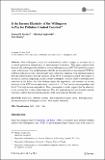Files in this item
Is the income elasticity of the willingness to pay for pollution control constant?
Item metadata
| dc.contributor.author | Barbier, Edward B. | |
| dc.contributor.author | Czajkowski, Mikołaj | |
| dc.contributor.author | Hanley, Nick | |
| dc.date.accessioned | 2016-07-01T10:30:05Z | |
| dc.date.available | 2016-07-01T10:30:05Z | |
| dc.date.issued | 2017-11 | |
| dc.identifier | 243772209 | |
| dc.identifier | 16d7bf12-bd42-4543-8d78-ab8b8240b91e | |
| dc.identifier | 84974801087 | |
| dc.identifier | 000415818900010 | |
| dc.identifier.citation | Barbier , E B , Czajkowski , M & Hanley , N 2017 , ' Is the income elasticity of the willingness to pay for pollution control constant? ' , Environmental and Resource Economics , vol. 68 , no. 3 , pp. 663-682 . https://doi.org/10.1007/s10640-016-0040-4 | en |
| dc.identifier.issn | 1573-1502 | |
| dc.identifier.other | RIS: Barbier2016 | |
| dc.identifier.uri | https://hdl.handle.net/10023/9069 | |
| dc.description | The authors are grateful for the financial support provided by four Finnish Ministries (Ministry of Agriculture and Forestry, Ministry of Environment, Ministry of Transport and Communications and Ministry of Finance), the Swedish Research Council for Environment, Agricultural Sciences and Spatial Planning (Formas); the Danish Strategic Research Council; the German Federal Environment Agency (UBA, Fkz 3710 25 202); and the Swedish Environmental Protection Agency. MC gratefully acknowledges the support of the Polish Ministry of Science and Higher Education and the Foundation for Polish Science. NH thanks MASTS for funding part of his work. | en |
| dc.description.abstract | How willingness to pay for environmental quality changes as incomes rise is a central question in several areas of environmental economics. This paper explores both theoretically and empirically whether or not the willingness to pay (WTP) for pollution control varies with income. Our model indicates that the income elasticity of the marginal WTP for pollution reduction is only constant under very restrictive conditions. Our empirical analysis tests the null hypothesis that the elasticity of the WTP for pollution control with respect to income is constant, employing a multi-country contingent valuation study of eutrophication reduction in the Baltic Sea. Our findings reject this hypothesis, and estimate an income elasticity of the WTP for eutrophication control of 0.1–0.2 for low-income respondents and 0.6–0.7 for high-income respondents. Thus, our empirical results suggest that the elasticity is not constant but is always less than one. This has implications for how benefits transfer exercises, and for theoretical explanations of the environmental Kuznets curve. | |
| dc.format.extent | 20 | |
| dc.format.extent | 893757 | |
| dc.language.iso | eng | |
| dc.relation.ispartof | Environmental and Resource Economics | en |
| dc.subject | Baltic Sea | en |
| dc.subject | Benefits transfer | en |
| dc.subject | Environmental Kuznets curve | en |
| dc.subject | Eutrophication | en |
| dc.subject | Income | en |
| dc.subject | Elasticity of willingness to pay | en |
| dc.subject | Non-market valuation | en |
| dc.subject | GE Environmental Sciences | en |
| dc.subject | HB Economic Theory | en |
| dc.subject | NDAS | en |
| dc.subject | SDG 14 - Life Below Water | en |
| dc.subject.lcc | GE | en |
| dc.subject.lcc | HB | en |
| dc.title | Is the income elasticity of the willingness to pay for pollution control constant? | en |
| dc.type | Journal article | en |
| dc.contributor.institution | University of St Andrews. Geography & Sustainable Development | en |
| dc.identifier.doi | 10.1007/s10640-016-0040-4 | |
| dc.description.status | Peer reviewed | en |
This item appears in the following Collection(s)
Items in the St Andrews Research Repository are protected by copyright, with all rights reserved, unless otherwise indicated.

